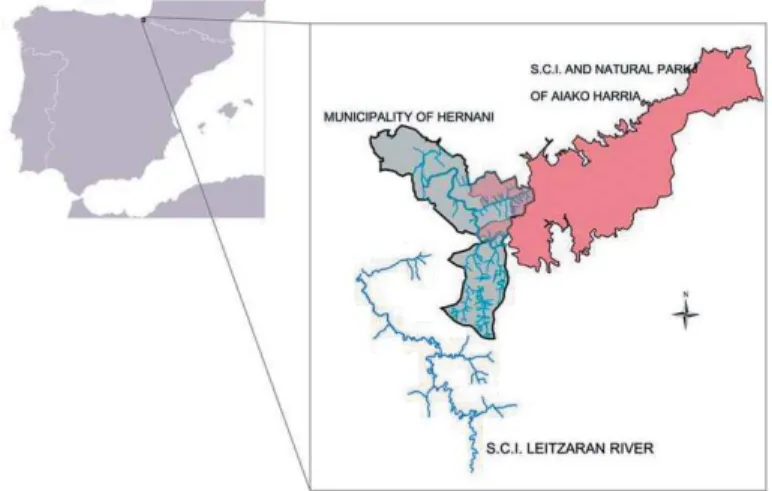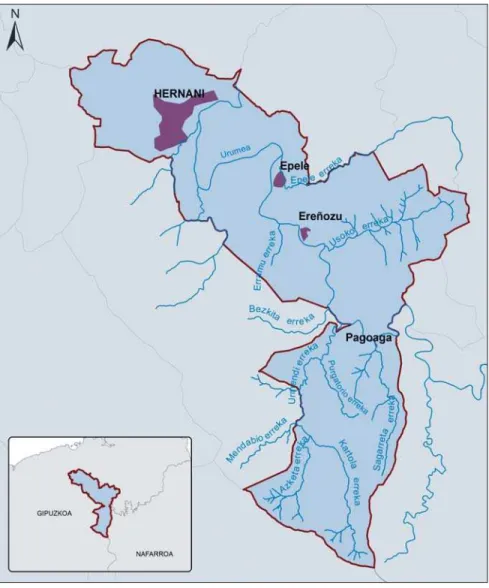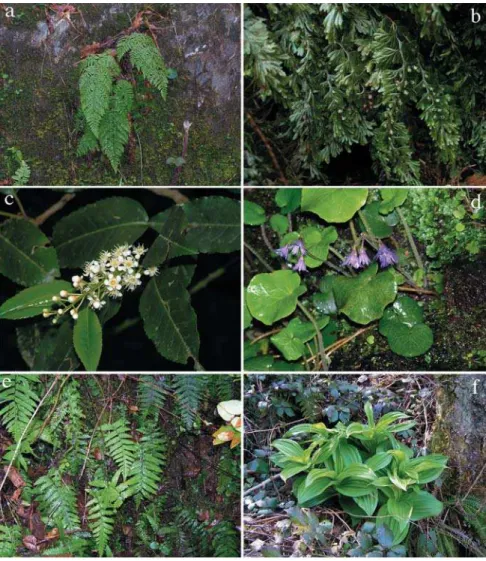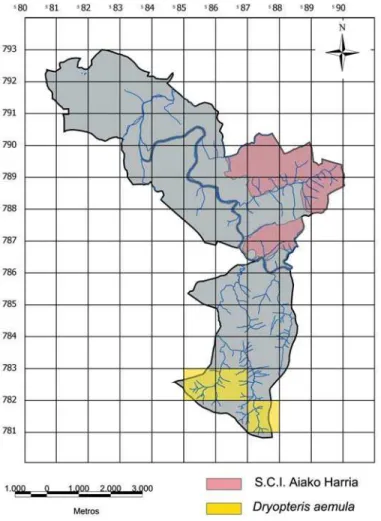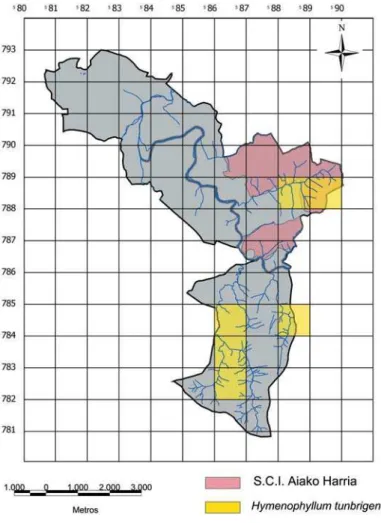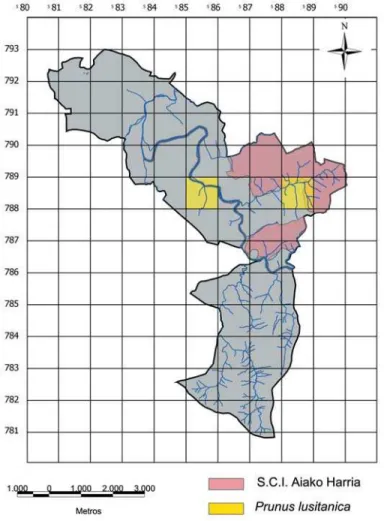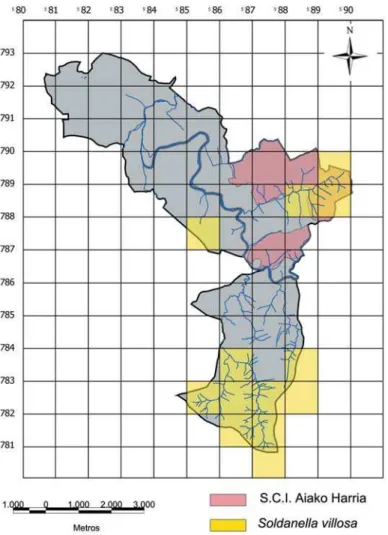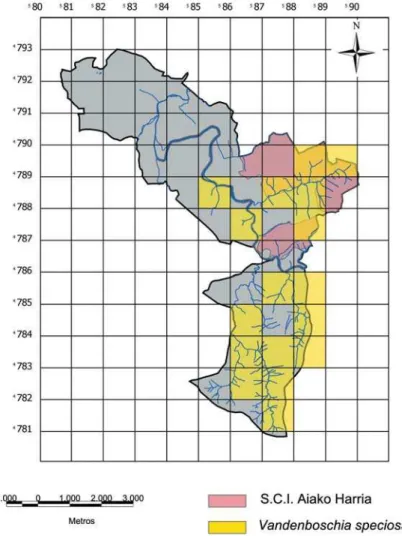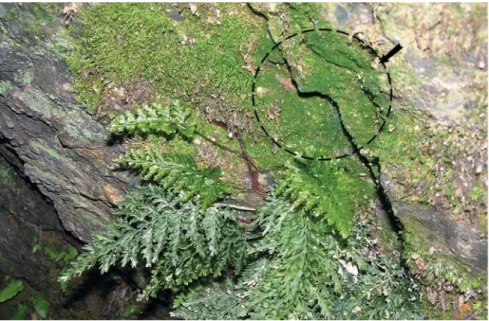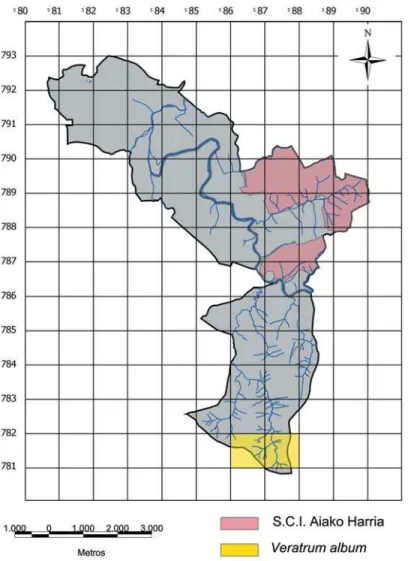Inventory and mapping of red-listed vascular
flora in Hernani municipality
(Gipuzkoa, Basque Country).
Mehatxu egoeran dauden landareen inbentarioa eta kartografia
Hernani udalerrian (Gipuzkoa, Euskal Autonomia Erkidegoa).
IÑAKISANZ-AZKUE1, JOSERRADÍEZ-LÓPEZ2, IBAIOLARIAGA-IBARGUREN1,2*
ABSTRACT
A total of 119 new chorological reports are given for 7 red-listed species, namely, Dryopteris aemula, Hymenophyllum tunbrigense, Prunus lusitanica, Soldanella villosa, Stegnogramma pozoi, Vandenboschia speciosa, and Vera-trum album. Comments on their ecology and local distribution maps are pro-vided. The number of subpopulations of S. villosa (52) and T. speciosum (38) found is remarkable. In several streams, the gametophyte phase of T. specio-sum, rarely reported in the Iberian Peninsula, exceeds the sporophyte gene-ration in number of individuals, which probably has important conservation and genetic diversity implications. It is proposed that the Urumea Site of Communitary Interest be extended to cover the streams that discharge into it, or alternatively, threatened plant microreserves be established at the Apaizeta, Azketa and Kartola streams.
• KEY WORDS: Threatened flora, Pterydophyta, conservation, management, Natural Park.
LABURPENA
Guztira, zerrenda gorrian dauden zazpi landareren 119 aipu korologiko ematen dira: Dryopteris aemula (Aiton) Kuntze, Hymenophyllum tunbri-gense(L.) Sm., Prunus lusitanicaL., Soldanella villosaDarracq ex Labarrère, Stegnogramma pozoi (Lag.) K. Iwats., Vandenboschia speciosa (Willd.) G. Kunkel., eta Veratrum album L.; baita euren kartografia herri mailako
1 Society of Sciences of Aranzadi
Zorroagagaina 11 •20014 Donostia-San Sebastián
2 University of the Basque Country/EHU. Department of Plant Biology and Ecology, Apdo. 644 •48080 Bilbao
eskalan eta euren ekologiari buruzko aipamenak. Aipagarria da, bestalde, aurkituriko S. villosa eta V. speciosa-ren azpipopulazio kopuru altua, 52 eta 38koa, hurrenez hurren. Erreka batzuetan V. speciosagametofito faseak topa-tu dira –Iberiar Penintsulan oso gutxitan aipatopa-tua– esporofito faseak baino indi-biduo gehiagorekin, horrek V. speciosa-ren kontserbazioan eta dibertsitate genetikoan dituen inplikazio garrantzitsuekin. Ondorio bezala, Urumea Interes Bereziko Gunea izendatzea proposatzen dugu, barne har ditzan bertara isurtzen duten erreka eta bailara txikiak ere; edota, bestela, Apaizeta, Azketa eta Kartola erreketan landare mehatxatuen mikroerreserbak ezartzea.
• GAKO-HITZAK: Flora mehatxatua, Pterydophyta, kontserbazioa, kudeaketa,
Parke Naturala.
RESUMEN
Se dan 119 citas corológicas de 7 especies amenazadas: Dryopteris aemula, Hymenophyllum tunbrigense, Prunus lusitanica, Soldanella villosa, Stegno-gramma pozoi, Vandenboschia speciosa y Veratrum album. Se aportan co-mentarios ecológicos y mapas de distribución. El número de subpoblaciones de S. villosa (52) y T. speciosum (38) halladas es remarcable. En diversas rega-tas se ha encontrado la fase gametofítica de T. speciosum, raramente citada en la Península Ibérica, que además excede en número de individuos a la fase esporofítica, lo cual tiene importantes implicaciones en cuanto a la diversidad genética y consercación de V. speciosa. Proponemos que el lugar de interés comunitario Urumea sea extendido para englobar también las regatas que flu-yen al Urumea, o alternativamente, que se establezcan microreservas de plan-tas amenazadas en las regaplan-tas de Apaizeta, Azketa y Kartola.
•PALABRAS CLAVE: Flora amenazada, Pterydophyta, conservación, gestión, Par-que Natural.
INTRODUCTION
The flora of Hernani municipality remains relatively poorly studied. Contrastingly, the neighbouring Aiako Harria Natural Park and Leitzaran valley have been visited more often by botanists, and focused inventories have been made (Allorge & Allorge, 1941; Aseginolaza et al., 1985; Catalán & Aizpuru, 1985; Arbelaitz et al.,2002). Due to its geographical proximity, and similar eco-logical conditions, Hernani also hosts some of the red-listed species (Spanish and Basque). A few records of red-listed species have been reported in the last few decades in Hernani, including Hymenophyllum tunbrigense (L.) Sm., Dryopteris aemula (Aiton) O. Kunze and Trichomanes speciosum Willd. (Aseginolaza et al.,1985; Aizpuruet al.,1990; Arbelaitz et al.,2002). However, a number of remote and potentially interesting areas of Hernani have rarely, if ever, been visited by botanists. This led us to the conclusion that further
lations of red-listed species might be present, and/or that additional red-listed species might be found.
A project inventory of red-listed vascular flora in Hernani, mapping every sub-population, was carried out from 2007 to 2009. The main purpose was to pro-vide management and protection measures, to ensure the conservation of these populations. Additionally, the inventory and mapping of new populations and subpopulations of red-listed species is of paramount importance on a broader scale, for assessment of population trends, threats, and the conservation status of the species (Bañares et al.,2008, 2010; Moreno, 2008) in a wider geographi-cal context.
Thus, this paper provides new chorological records of species, resulting from the project cited above. Several red-listed species are reported, which are inclu-ded either in the 2008 Red List of Spanish Vascular Flora (Moreno 2008, referred to as SRL below), or in the Red List of Vascular plants (Aizpuru et al., 2010, referred to as BRL below), including the updated version (Department of Environment, TERRITORY Planning, Agriculture and Fishery 2011) or pro-tected under the Bern Convention, or by the Communitary Habitat Directive. This information contributes to greater knowledge of their distribution, conser-vation state, and assessment of their red-listed status. Furthermore, comments are provided concerning their ecology and biology in the territory.
MATERIALS AND METHODS
Study area
Hernani municipality is situated in the north-eastern part of Gipuzkoa (Basque Country), in the eastern corner of the Bay of Biscay (Fig. 1). Hernani covers an area of 42 km2, and has an elongated and narrow shape. The nearest point to
the sea, 5 km inland, is in the north of the municipality, and the area borders Navarre province to the south. The Urumea river flows north-westwards across the municipality, and all the streams in Hernani discharge into it (Fig. 2). It is a mountainous area, with the highest peaks being found in the southern part of the municipality (Zaburu 780 m, Azketa-Antxista 834 m). Two areas of the municipality are protected, namely the Urumea Ibaia/Río Urumea Site of Communitary Interest (ES2120015), plus a small part (385 ha) that is included in the Aiako Harria Natural Park (also S.C.I., ES2120016).
With regard to the lithology, slate and grey are the predominant rocks in eas-tern Hernani, forming steep and narrow valleys. Downstream, dark grey marls are also present, and in the western part of the study area, where the valleys are more shallow, alluvial deposits, sandy limestone and marls form a mosaic in the hilly landscape (Sanz-Azkue et al. 2007).
The climax vegetation of Hernani (Loidi et al.2011) mainly consists of acidop-hilous oak forests (Hyperico pulchri Quercetum roboris [Br.-Bl. 1967] Rivas-Martínez, Báscones, T.E. Díaz, Fernández-González & Loidi 1991), and acidop-hilous beech forests (Saxifrago hirsutae Fagetum sylvaticae Br.-Bl. 1967 em. Rivas-Martínez, Báscones, T.E. Díaz, Fernández-González & Loidi 1991) above 400-500 m a.s.l., with riparious alder forests along the streams and rivers (Hyperico androsaemi Alnetum glutinosae[Br.-Bl. 1967] Rivas-Martínez in Loidi 1983). However, the municipality has been densely populated and the landsca-pe has been modified for many years, in such a way that grasslands, shrub com-munities, and exotic tree plantations are now important components of the landscape. The remaining stands of climax vegetation are scattered and have undergone intensive charcoal-making activity prior to the first third of the twen-tieth century.
Sampling methodology
We prospected part of the Urumea river, and particularly the streams that dis-charge into it, for red-listed plants. The coordinates of each subpopulation
Fig. 1.- The location of Hernani municipality in the northern central area of the Iberian Peninsula and relative to the Sites of Communitary Interest, the Leitzaran River and the Aiako Harria Natural Park.
found were obtained with the aid of a Garmin Etrex Vista SUMMIT GPS. When the accuracy of the coordinates was insufficient, coordinates were obtai-ned using SIGPAC (http://sigpac.mapa.es/fega/visor/). Coordinates are given in ED50 geodetic datum. Distribution maps were created using gvSIG software (http://www.gvsig.com/). Material from all the subpopulations we located was collected and deposited in the ARAN herbarium (Holmgrenet al., 1990).
Fig. 2.- Map of the Hernani municipality showing the main streams that discharge into the Urumea river.
Fig. 3.- Threatened plants targeted in this study. a) Dryopteris aemula, ARAN 69280. b) Hymenophyllum tunbrigense, ARAN 69627. c) Prunus lusitanica, ARAN 69621. d) Soldanella villosa, ARAN 69156. e) Stegnogramma pozoi, ARAN 69628. f) Veratrum album, ARAN 69268.
3. Irudia - Lan honetan aurkitutako landare mehatxatuak. a) Dryopteris aemula, ARAN 69280.
b) Hymenophy-llum tunbrigense, ARAN 69627. c) Prunus lusitanica, ARAN 69621.
RESULTS
Chorologic reports by species
Dryopteris aemula(Aiton) Kuntze (Fig. 3a)
Material examined: ESP. GIPUZKOA (SS): Hernani, Azketa erreka, 30TWN8682, 334 m, very abundant along the watercourse, slope in the shade, 19-04-2009, I. Sanz & I. Olariaga, ARAN 69280. Hernani, Kartola erreka, 30TWN8781, 600 m, slope along the stream, in the shade, 4-04-2009, I. Sanz &I. Olariaga, ARAN 69269. Hernani, Ursaltueta erreka, 30TWN8582, 386 m, earthy slope near the watercourse, 10-07-2009, I. Sanz&I. Olariaga, ARAN 69279.
Fig. 4.- Map displaying the new subpopulations of D. aemulafound in Hernani municipality. The 1x1 km2 grids where it is present are marked in yellow.
4. Irudia - Hernanin aurkituriko D. aemulasubpopulazioak kokatzen direneko 1x1 km2koadrikulak adierazten
Notes: A paleotropical fern included in the SRL under the Vulnerable (D2) cate-gory, and Nearly Threatened in the BRL. In spite of being widespread but uncommon along the Cantabric coast (Castroviejo et al., 1986), it has been con-sidered as a very rare species by several authors (Aseginolaza et al., 1985; Aizpuru et al.,1999). In Hernani, D. aemulahas been found along the streams found in three steep valleys, forming very abundant populations (Fig. 4). We have been unable to find the plant in Pagoaga erreka, where Aseginolaza et al.(1985) previously reported it, despite visiting the area several times.
Hymenophyllum tunbrigense(L.) Sm. (Fig. 3b).
Material examined: ESP. GIPUZKOA (SS): Hernani, Apaizeta erreka, 30TWN8888, 290 m, earthy slope near the stream, 30-12-2009, I. Sanz & I. Olariaga, ARAN 69639; 30TWN8888, 311 m, siliceous rocks near the water-course, 17-07-2009, I. Sanz & I. Olariaga, ARAN 69187; 30TWN8888, 333 m, siliceous rocks near the watercourse, I. Sanz & I. Olariaga, ARAN 69186. Hernani, Azketa erreka, 30TWN8683, 229 m, small cliff along the stream, close to a waterfall, 17-01-2010, I. Sanz &I. Goñi, ARAN 69623; 30TWN8682, 334 m, large siliceous rocks near the watercourse, 19-04-2009, I. Sanz &I. Olariaga, ARAN 69183; 30TWN8682, 334 m, large siliceous rocks near the watercourse, 19-04-2009, I. Sanz &I. Olariaga, ARAN 69185; 30TWN8682, 337 m, large sili-ceous rocks near the watercourse, 19-04-2009, I. Sanz & I. Olariaga, ARAN 69184. Hernani, Izeneder erreka, 30TWN8988, 424 m, on two rocks 2 m from the stream, 30-12-2009, I. Sanz &I. Olariaga, ARAN 69634. Hernani, Kartola erreka, 30TWN8683, 219 m, shaded cliff near the watercourse, 14-03-2009, I. Sanz &I. Olariaga, ARAN 69627; 30TWN8684, 158 m, siliceous rocks near the watercourse, 14-03-2009, I. Sanz &I. Olariaga, ARAN 69182. Hernani, Sagarreta erreka, 30TWN8847, 210 m, Pinus radiata afforestation, on a large siliceous rock, 28-03-2009, I. Sanz &I. Olariaga, ARAN 69181.
Notes: This fern is also included as Vulnerable (B2, D2) in the SRL and BRL. A few records are known in the Basque Country, where the plant seems to be very localized and uncommon. In Hernani, 11 new subpopulations of H. tun-brigense have been found during this study (Fig. 5), which are distributed over 6 different km2grids. Previous to this work, H. tunbrigensewas only known in
the collector’s (Xabier Lizaur, pers. com.) precise indications of its location, we were unable to find it again.
Prunus lusitanica L. (Fig. 3c)
Material examined: ESP. GIPUZKOA (SS): Hernani, Apaizeta erreka, 30TWN8888, 211 m, near a stream on siliceous bedrock, 17-07-2009, I. Sanz & I. Olariaga, ARAN 69273. Hernani, Erramuerreka, 30TWN8588, 221 m, scattered along a stream for approximately 75 m, 7-02-2010, I. Sanz, ARAN 69621.
Fig. 5.- Map displaying the new subpopulations of H. tunbringensefound in Hernani municipality. The 1x1 km2grids where it is present are marked in yellow.
5. Irudia - Hernanin aurkituriko H. tunbringensesubpopulazio berriak dauden 1x1 km2koadrikulak horiz
Notes: Prunus lusitanica is a species of great biogeographic interest that is included in the SRL as Vulnerable (B2). In the Basque Country, it is categorized as at Critical Extinction Risk in the BRL, as well as in the last updated version produced in 2011. There are very few records of this species in the northern central area of the Iberian Peninsula (Beltrán, 2006); in the Basque Country it is known in only 5 of the km2grids (Aizpuru et al.,2010), and it has been
recor-ded only once in Gipuzkoa (Lizaur & Terés, 1995). We found P. lusitanica at two sites in Hernani (Fig. 6), occurring on siliceous bedrock, alongside streams in narrow valleys, at a relatively low elevation. This habitat conforms to the eco-logical requirements described for this species in the northern area of the
Fig. 6.- Map displaying the new subpopulations of P. lusitanicafound in Hernani municipality. The 1x1 km2 grids where it is present are marked in yellow.
Iberian Peninsula (Beltrán, 2006). The subpopulation of Erramuerreka erreka encompasses three reproductive individuals, and the one in Apaizeta four non-reproductive plants (Ihobe 2011).
Soldanella villosa Darracq ex Labarrère (Fig. 3d)
Iberian Peninsula (Castroviejo et al., 1990). The new records at Hernani com-plete a gap in the distribution area of this species (Fig. 7), since it is already known in the neighbouring Aiako Harria and the Leitzaran valley (Aseginolaza et al.,1985). In Hernani, S. villosa has been found in the southern part of the municipality, showing high habitat plasticity and mostly occurring near small waterfalls and streams, on wet slopes etc. However, the most important colo-nies are found in still water springs (Santodomingo erreka, Azketa) where S. villosathrives, covering large areas. From the total number of subpopulations
Fig. 7.- Map displaying the new subpopulations of S. villosafound in Hernani municipality. The 1x1 km2grids where it is present are marked in yellow.
found within Hernani (52), the abundance of S. villosa would appear to be simi-lar, or even higher than, that reported in the Aiako Harria Natural Park (Arbelaitz et al.,2002), which is in the central zone of the species distribution area. Furthermore, S. villosahas been found in 13 new km2grids in Hernani, a
significative amount considering that this species has previously been reported in only 29 of the km2 grids throughout the whole of the Basque Country
(AIZPURUet al.,2010).
Stegnogramma pozoi(Lag.) K. Iwats. (Fig. 3e)
Material examined: ESP. GIPUZKOA (SS): Hernani, Azketa erreka, 30TWN8682, 344 m, shaded cliff, under a spring, 19-04-2009, I. Sanz & I. Olariaga, ARAN 69277. Hernani, Epele erreka, 30TWN8789, 97 m, slope close to the stream, 17-01-2010, I. Sanz, ARAN 69628; 587141 4790058, 59 m, small slope near the stream, 17-01-2010, I. Sanz, ARAN 69629. Hernani, Erramuerreka, 30TWN8588, 20 m, on a slope between waterfalls, 06-04-2010, I. Sanz, ARAN 69624. Hernani, Kartola erreka, 30TWN8683, 170 m, small spring, near the main watercourse, 14-03-2009, I. Sanz & I. Olariaga, ARAN 69275. Hernani, Purgatorio erreka, 30TWN8684, 190 m, shaded cliff near a waterfall, 25-07-2009, I. Sanz & I. Olariaga, ARAN 69276. Hernani, Urmendi erreka, 30TWN8685, 80 m, small slope near the track, 17-01-2010, I. Sanz &I. Goñi, ARAN 69625.
Notes: Some additional, new localities of this biogeographically interesting fern are provided. It seems to be widespread in suitable habitats within the Basque Country (Aseginolaza et al.,1985). Although it is neither in the BRL nor the SRL, in the neighbouring Navarre it is considered to be sensitive to habitat degrada-tion (Anonymous, 1997), and the species is strictly protected in France (OLIVIER et al.,1995).
Vandenboschia speciosa (Willd.) G. Kunkel.1
Trichomanes speciosum Willd.
Material examined: ESP. GIPUZKOA (SS): Hernani, Apaizeta erreka, 588747 4788528, 316 m, under two rocks, near a waterfall, in the shade, 17-07-2009, I. Sanz &I. Olariaga, ARAN 69130; 588817 4788436, 211 m, earthy slope near the waterfall, 17-07-2009, I. Sanz &I. Olariaga, ARAN 69129, [fertile]. Hernani, Azketa erreka, 30TWN8682, 344 m, close to waterfall, under two rocks, 19-04-2009, I. Sanz &I. Olariaga, ARAN 69122, [fertile]; 30TWN8682, 336 m, close to the stream in the shade in a small cave, 19-04-2009, I. Sanz &I. Olariaga, ARAN 69124, [fertile]; 30TWN8682, 321 m, near the main watercourse, in a spring, 19-04-2009, I. Sanz &I. Olariaga, ARAN 69126; 30TWN8683, 278 m, under two rocks lying near a waterfall, in the shade, 19-04-2009, I. Sanz & I. Olariaga,
1 The cited materials consist of sporophytes, unless otherwise indicated. The material with sporangia is referred to as fertile.
I. Sanz &I. Olariaga, ARAN 69262; 30TWN8884, 270 m, on a cliff in the shade, 28-03-2009, I. Sanz & I. Olariaga, ARAN 69261. Hernani, Saratsain erreka, 30TWN8687, 41 m, in the watercourse, in the shade, 13-06-2009, I. Sanz & I. Olariaga, ARAN 69287. Hernani, Urmendi erreka, 30TWN8684, 127 m, near the watercourse, shaded cliff, 6-06-2009, I. Sanz & I. Olariaga, ARAN 69284; 30TWN8684, 142 m, spring near the watercourse, 6-06-2009, I. Sanz & I. Olariaga, ARAN 69283, [fertile].
Notes: A species which is included as Vulnerable (B1, D2) in the SRL and the updated BRL of 2011. This paleotropical fern has been cited in a few localities
Fig. 8.- Map displaying the new subpopulations of V. speciosafound in Hernani municipality. The 1x1 km2 grids where it is present are marked in yellow.
within Gipuzkoa (Catalán & Aizpuru, 1985; Lizaur & Terés, 1995; Aizpuru et al., 2005). It has also been reported at two localities in Hernani (Aizpuru et al., 1990; ARBELAITZ et al., 2002), which we have confirmed during our study. We also found 38 new sporophyte subpopulations of V. speciosawithin Hernani (Fig. 8), distributed in 17 of the km2 grids (15 of which were new sites).
This contrasts with previous recordings in only 27 grids across the whole of the Basque Country. This high number is remarkable, considering the scarceness of the species in the neighbouring Aiako Harria Natural Park and the Leitzaran Valley, and in the Iberian Peninsula in general (Arbelaitz et al. 2002).
V. speciosais one of the few ferns (the only one in Europe) in which the two generations of its life cycle (gametophyte and sporophyte) are perennial and can live independently. The gametophyte can reproduce asexually by produ-cing vegetative propagules, resulting in populations which do not contain the sporophyte (Rumsey et al., 1998, 1999). Solely gametophytes are known in many areas of north and central Europe (Vogelet al., 1993; Rumsey et al.,1998; Turo_ová, 2005), where, conversely, the sporophyte is unknown. To our know-ledge, the gametophyte phase has very rarely been reported in the Iberian Peninsula, only in Cádiz (Pérez Latorre et al., 2005), Biscay and Cantabria (J. Garmendia, pers. comm.), and the northern part of Navarre (Oreja 2008). It has also been reported a few times in the French Basque Country (Loriot, 2005). Fieldwork during this study showed that the gametophyte generation (Fig. 9),
Fig. 9.- In-situ photograph of V. speciosa(ARAN 69149), showing the sporophyte and gametophyte generations. The arrow and broken circle indicate a gametophyte patch.
previously overlooked, is not only present but widespread within suitable habi-tats in Hernani. Fieldwork in collaboration with the research team of Dr. Víctor Suárez (University of Granada), revealed that in some streams most individuals of the V. speciosa populations correspond to the gametophyte generation. The gametophyte individuals exceeded the sporophytes in the Apaizeta (14 gametophytes, 2 sporophytes) and Branketa streams (16, 2), whilst numbers were more or less equal in other streams, such as Azketa (19 gametophytes, 18 sporophytes), Larrakaitz (8, 6) and Usoko (6, 6). This variation may be due to the differing habitat requirements of the gametophyte and sporophyte gene-rations (Makgomol & Sheffield, 2001; Kingston & Hayes, 2005) and changes in habitat availability from stream to stream.
It has been noted that the sporophyte generation seldom possesses sporangia in the Iberian Peninsula (Castroviejo et al.,1986), at least in the herbarium mate-rial, as Aizpuru et al.(1999) also claimed for the Basque Country. In Hernani, at least 11 of the 48 colonies discovered were fertile.
Veratrum albumL. (Fig. 3f)
Material examined: ESP. GIPUZKOA (SS): Hernani, between Antxista and Unamuno peaks, 30TWN8681, 763 m, peat bog with Sphagnum and Polytrichum commune, at edge of Larix kaempferi plantation, 4-04-2009, I. Sanz &I. Olariaga, ARAN 69270. Hernani, Santodomingo erreka, 30TWN8681, 726 m, spring coming out of the ground, in an alder stand, together with Soldanella villosa, 13-04-2009, I. Sanz & I. Olariaga, ARAN 69274; 30TWN8781, 714 m, shaded spring in Alnus glutinosaand Salix atrocinereastand, stony, 4-04-2009, I. Sanz &I. Olariaga, ARAN 69268.
Notes: Veratrum album is considered as a species of Special Interest in the BRL, its populations being highly isolated and containing few individuals (Uribe-Echebarria & Campos, 2006). In spite of having been cited in a few localities in Gipuzkoa (Aseginolaza et al., 1985; Catalán & Aizpuru, 1985; Aizpuru et al., 2004), this species was unknown in the Adarra-Mandoegi chain. The three new sites we found (Fig. 10) are at springs located in the montane stage. The sub-population where ARAN 69268 was collected is of particular importance since it contains ca. 25 individuals.
General results
as a whole, and also the proportion located in Hernani. Hernani hosts 33% of the km2grids within the Basque Country where H. tubringenseis known, along
with 31% of S. villosaand 37% of V. speciosa. Tab. 3 compares the number of subpopulations of threatened species known in the Aiako Harria Natural Park (S.C.I.), with the number of subpopulations from Hernani that are located within the protected area, and outside it. Most of the subpopulations of threa-tened plants found in Hernani are located outside protected areas.
Fig. 10.- Map displaying the new subpopulations of V. albumfound in Hernani municipality. The 1x1 km2grids where it is present are marked in yellow.
Table 1.- Number of subpopulations of threatened plants by species in different streams across Hernani. The column total indicates the total number of subpopulations in each stream. Asterisks indicate the presence of subpopulations with remarkably abundant individuals.
1. Taula - Landare mehatxatu subpopulazio kopurua erreka bakoitzeko Hernaniko udalerrian, espeziez espezie. Azken zutabeak erreka bakoitzeko landare mehatxatu subpopulazio kopurua darakus. Asteriskoek indibiduo kopurua de la eta azpimarragarriak diren subpopulazioak adierazten dituzte.
Table 2.- Number of 1x1 km2grids in which D. aemula, H. tunbringense, P. lusitanica, S. villosa, V. speciosa
and V. albumare found in the Basque Country and the Hernani municipality, along with the proportion of grids located in Hernani.
2. Taula - Dryopteris aemula, H. tunbringense, P. lusitanica, S. villosa, V. speciosa and V. album1 x 1 km2
karratu kopurua E.A.E.n eta Hernanin, eta Hernanin kokatuta dauden 1 x 1 km2karratu proportzioa.
Stream D. aemula tunbrigense lusitanica speciosa H. P. S. villosa V. V. album Total
Erramuerreka 0 0 1 0 1 0 2
Saratsain 0 0 0 1 1 0 2
Purgatorio 0 0 0 0 2 0 2
Urmendi 0 0 0 1 2 0 3
Azketa 1* 4 0 9* 10 0 25
Ursaltueta 1 0 0 1* 0 0 2
Kartola 1 2 0 18* 5 1 27
Santodomingo 0 0 0 10* 0 2 12
Sagarreta 0 1 0 2 4 0 7
Larrakaitz 0 0 0 0 6 0 6
Lizarregi 0 0 0 0 1 0 1
Apaizeta 0 3 1 6* 2 0 12
Izeneder 0 1 0 3 0 0 4
Usoko 0 0 0 1 2 0 3
Branketa 0 0 0 0 2 0 2
Basque Hernani % of 1x1 km Country municipality grids in Hernani
D. aemula 38 3 8
H. tunbrigense 18 6 33
P. lusitanica 7 2 29
S. villosa 42 13 31
T. speciosum 44 17 37
DISCUSSION
Previous to this study, only three red-listed species had been cited in Hernani, at a total of four sites, namely Hymenophyllum tunbrigense, Dryopteris aemula and Vandenboschia speciosa (Aseginolaza et al., 1985; Aizpuru et al., 1990; ARBELAITZet al.,2002). This study has contributed not only to the mapping of new subpopulations of these species, but also to the discovery of Prunus lusi-tanica, Soldanella villosa, Stegnogramma pozoi, and Veratrum album in Hernani. This makes a total of six red-listed species, all of which are associated with stream and spring microhabitats. Four of these species are paleotropical ferns, which find a suitable habitat in the narrow and steep valleys that are cha-racterized by special conditions of high humidity and constant temperature. A total of 112 subpopulations of the six red-listed plant species have been pre-cisely mapped as an outcome of this study, which is highly important from a conservational point of view. The abundance of subpopulations of S. villosa and V. speciosais comparable, or even higher, than that reported in the Aiako Harria Natural Park (Arbelaitz et al. 2002). Considering the subpopulations from Hernani, most of the new reports are located outside the Aiako Harria. Thus, Hernani is likely to harbour some of the most important populations of certain species, such as S. villosa and V. speciosa, not only on a regional scale, but also in the wider Iberian context.
As mentioned above, a small part of Hernani municipality is included in the Aiako Harria Natural Park. Remarkably, a large proportion of the subpopula-tions have been found outside this area. Furthermore, all the species have at least one population outside the protected area, where intense forestry activi-ties may represent a serious threat to some of them. The design and
establish-Table 3.- . Number of subpopulations of threatened plants known in the Aiako Harria S.C.I., together with the subpopulations within Hernani and either in or outside the Aiako Harria S.C.I.
3. Taula - Aiako Harria I.B.G.-an ezagutzen den landare mehatxatu subpopulazio kopurua, eta Hernanin aurki-tutako subpopulazioen artean, zenbat diren Aiako Harria I.B.G. barruan eta zenbat kanpoan.
AIAKO HERNANI MUNICIPALITY
HARRIA In Aiako Outside Aiako
S.C.I. Harria S.C.I. Harria S.C.I.
D. aemula 0 0 3
H. tunbrigense 7 2 4
P. lusitanica 1 1 1
S. villosa 24 3 10
T. speciosum 6 2 15
ment of special protection microreserves, similar to the microreserve network implemented in dune habitats in the Basque Country (García-Mijangos et al. 2011) and in the south-east of the Iberian Peninsula (Laguna et al., 2004), could be a suitable solution for supporting the conservation of these popula-tions in the future. As a result of this work, we propose that the Urumea S.C.I. be extended to all small valleys and to the streams that discharge into this river, in order to protect the subpopulations of threatened plants found here. Alternatively, if this first proposal is not achievable, the Azketa, Kartola and Apaizeta streams should be declared as threatened plant microreserves.
ACKNOWLEDGEMENTS
We wish to acknowledge the Hernani town council for funding this work, and especially Olatz Urrutibeaskoa, for her constant support. Likewise, we are grateful to the guards working in the municipality, for sharing their knowledge and helping us avoid long walks. We thank Anaïs Mitxelena for her assistance with databasing, as well as for efficiently solving many practical problems. Ana Felipe has also notably contributed to the improvement of the mapping of the targeted species. We are grateful to Xabier Lizaur for providing detailed information on his find of H. tunbrigense at Oindi peak. We also thank Iñaki Aizpuru, Ibon Tamayo, and Joseba Garmendia, for kindly answering our questions and doubts. Víctor Suárez, Marta Nieto and Samira Ben-Menni (University of Granada) shared three days in the field with us, during which time the number of gametophyte individuals per stream could be estimated.
BIBLIOGRAPHY
• Aizpuru, I., Aperribai, J.A., GARIN, F. 1990. “1989-1990”. Araba, Bizkaia eta Gipuzkoako Landare katalogoari eraskin eta zuzenketak (II). Munibe, Cienc. Nat. 41: 123-126.
•Aizpuru, I., Arbelaitz, E., Garmendia, J., Olariaga, I., Terés, J., Zendoia, I. 2005. Contribuciones al conocimiento de la flora del País Vasco (VII). Munibe, Cienc. Nat.56: 55-60.
•Aizpuru, I., Aseginolaza, C., Uribe-Echebarria, P.M., Urrutia, P., Zorrakin, I. 1999.
Claves ilustradas del País Vasco y territorios limítrofes. Gobierno Vasco. Vitoria-Gasteiz.
•Aizpuru, I., Tamaio, I., Uribe-Echebarría, P.M., Garmendia, J., Oreja, L., Balentzia, J., Patino, S., Prieto, A., Biurrun, I. Campos, J.A., García, I., Herrera, M. 2010. Lista roja de la Flora Vascular de la CAPV. Eusko Jaurlaritza-Gobierno Vasco. Disponible en web: www.conservacionvegetal.org/.../eaeko%20flora%20baskula-rraren%20zerrenda%20gorria.pdf
•Allorge, V., Allorge, P. 1941. Plantes rares ou interéssantes du NW de l’Espagne, principalement du Pays Basque. Bull. Soc. Bot. France88: 226-254.
• Anonymous. 1997. Creación del catálogo de la flora amenazada de Navarra y adopción de medidas para la conservación de la flora silvestre catalogada. Decreto Foral 94/1997, 7 April – Boletín Oficial de Navarra no. 47, 18/04/1997.
•Arbelaitz, E., Mendizabal, M., Tamayo, I., Aldezabal, A., Aseginolaza, C. 2002. Aiako Harria Parke Naturaleko mehatxaturiko flora (Gipuzkoa): I. Populazioen banaketa eta zentsoa. Munibe, Cienc. Nat.53: 131-146.
•Aseginolaza, C., Gómez, D., Lizaur, X., Montserrat, G., Morante, G., Salaverria, M.R., Uribe-Echebarria, P.M., Alejandre, J.A. 1985. Catálogo florístico de Alava, Vizcaya y Guipúzcoa“1984”. Gobierno Vasco-Eusko Jaurlaritza. Vitoria-Gasteiz.
•Bañares, Á., Blanca, G., Güemes, J., Moreno, J.C., Ortiz, S. (Ed.). 2008 Atlas y libro rojo de la Flora Vascular de España.Ministerio de Medio Ambiente y Medio Rural y Marino. Madrid.
•Bañares, Á., Blanca, G., Güemes, J., Moreno, J.C., Ortiz, S. (Ed.). 2010. Atlas y libro rojo de la Flora Vascular de España.Ministerio de Medio Ambiente y Medio Rural y Marino. Madrid.
• Beltrán, R.S. 2006. Distribución y autoecología de Prunus lusitanica L. en la Península Ibérica. Invest. Agrar. Sist. Recur. For. Fuera de serie: 187-198.
•Castroviejo, S., Laínz, M., López-González, G., Montserrat, G., Muñoz Garmendia, F., Paiva, F., Villar, L. (Ed.). 1986. Flora Ibérica. Plantas vasculares de la Península Ibérica e Islas Baleares. Vol. I.CSIC. Madrid.
•Castroviejo, S., Laínz, M., López-González, G., Montserrat, P., Muñoz Garmendia, F., Paiva, J., Villar, L. (Ed.). 1990. Flora ibérica. Plantas vasculares de la Península Ibérica e Islas Baleares. Vol. II.CSIC. Madrid.
•Catalán, P., Aizpuru, I. 1985. Aportación al catálogo florístico de la cuenca del Bidasoa (Guipúzcoa y Navarra). Munibe, Cienc. Nat.37: 17-86.
•Departament of Environment, Territory Planning, Agriculture and Fishery. 2011. Update of the Basque Catalogue of Threatened species of Wild and Marine Fauna and Flora. EHAA-BOPV 37: 1-12 (23 February 2011).
•Holmgren, P.K., Holmgren, N.H., Barnett, L.C. (Ed.) 1990. Index Herbariorum. Part I: The Herbaria of the World (Regnum Veg. vol. 120). New York Botanical Garden. New York.
protected areas. Global strategy for plant conservation. Abstracts book: 62. Valencia 13-16th Setember 2011.
•Idom. 2004. Estado del Medio Ambiente en la Comunidad Autónoma del País Vasco.Edición Ihobe. Bilbao.
•Ihobe. 2011. Bases técnicas para la redacción de los Planes de Recuperación de la flora considerada “en peligro crítico de extinción” en la lista roja de la flora vas-cular de la CAPV. Flora 9: 1-148.
•Kingston, N., Hayes, K. 2005. The ecology and conservation of the gametophyte generation of the Killarney fern (Trichomanes speciosum Willd.) in Ireland. Biol. Environ. Proc. Royal Irish Acad.105B(2): 71-79.
•Laguna, E., Deltoro, V.I., Perez-Botella, J., Perez-Rovira, P., Serra, L.I., Olivares, A., Fabregat, C. 2004. The role of small reserves in plant conservation in a region of high diversity in eastern Spain. Biol. Conserv. 119: 421-426.
•Lizaur, X., Terés, J.L. 1995. Tres novedades para la flora guipuzcoana y otras citas de interés. Munibe, Cienc. Nat.47: 69-70.
•Loidi, J., Biurrun, I., Campos, J.A., García-Mijangos, I., Herrera, M. 2011. La vege-tación de la Comunidad Autónoma del País Vasco. Leyenda del mapa de series de vegetación a escala 1:50.000. Universidad del País Vasco (electronic version).
•Loriot, S. 2005. Pour une stratégie de conservation de Trichomanes speciosum Willd. dans le Massif Armoricain. Ph.D. thesis. Université de Bretagne occidentale.
•Makgomol, K., Sheffield, E. 2001. Gametophyte morphology and ultrastructure of the extremely deep shade fern, Trichomanes speciosum. New Phytol.151: 243-255.
• Moreno, J.C. (Coord.). 2008. Lista Roja 2008 de la flora vascular española. Dirección General de Medio Natural y Política Forestal (Ministerio de Medio Ambiente, y Medio Rural y Marino, y Sociedad Española de Biología de la Conservación de Plantas). Madrid.
• Olivier, L., Galland, J.-P., Maurin, H. 1995. Livre rouge de la flore menacée de France. Tome I: Espèces prioritaires. Museum National d’Histoire naturelle. Institut d’Ecologie et de gestion de la biodiversité. Service du patrimoine naturel.
•Oreja, L. 2008 (Ed.). Diagnóstico del estado de conservación y propuestas de ges-tión de Vandenboschia speciosa (Willd.) Kunkell en Navarra. Informe inédito. Gobierno Foral de Navarra, Gestión Ambiental Viveros y Repoblaciones de Navarra.
•Pérez Latorre, A.V., Cano, M.J., Cabezudo, B., Guerra, J. 2005. Phytocoenological behaviour, distribution and conservation of Trichomanes speciosum Willd. (Pteridophyta) in the south of the Iberian Peninsula. Cryptog. Bryol.26(3): 249-261.
• Rumsey, F.J., Vogel, J.C., Russell, S.T., Barrett, J.A., Gibby, M. 1999. Popu-lation structure and conservation biology of the endangered fern Trichomanes speciosum Willd. (Hymenophyllaceae) at its northern distributional limit. Biol. J. Linn. Soc. 66: 333-344.
•Sanz-Azkue, I., Olariaga, I., Díez, J. 2007. Hernaniko natur-ondarearen azterketa. Hernaniko Udala. Disponible en web: www.hernani.net/dokumentuak/.../hernani-ko_natur_ondarearen_azterketa.pdf
•Turo˘nová, D. 2005. Mapping and monitoring of killarney fern (Trichomanes spe-ciosum) in the Czech Republic. Ferrantia44: 233-236.
•Uribe-Echebarría, P.M., Campos, J.A. 2006. Flora vascular amenazada en la Comu-nidad Autónoma del País Vasco. Gobierno Vasco. Vitoria-Gasteiz.
•Vogel, J.C., Jessen, S., Gibby, M., Jermy, A.C., Ellis, L. 1993. Gametophytes of Trichomanes speciosum (Hymenophyllaceae: Pteridophyta) in Central Europe. Fern Gaz.14: 227-232.
